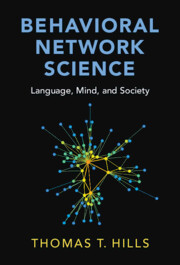Book contents
- Frontmatter
- Contents
- Additional Resources
- Introduction: Structure Matters
- Part I A Brief Guide to Network Science
- Part II Language
- 4 Zipf’s Law of Meaning: The Degree Distribution of the Mind
- 5 Network Learning: Growing a Lexicon by Degrees
- 6 What Is Distinctive: Exploring Edge Types in Multilayer Networks
- 7 The Small-World Spectrum: Using Small Worlds to Compare Networks
- 8 The Birthplace of New Words: Identifying Node Origins
- 9 Agent-Based Models of Language Emergence: Structure Favors the Orangutan
- Part III Mind
- Part IV Society
- References
- Index
8 - The Birthplace of New Words: Identifying Node Origins
from Part II - Language
Published online by Cambridge University Press: 08 November 2024
- Frontmatter
- Contents
- Additional Resources
- Introduction: Structure Matters
- Part I A Brief Guide to Network Science
- Part II Language
- 4 Zipf’s Law of Meaning: The Degree Distribution of the Mind
- 5 Network Learning: Growing a Lexicon by Degrees
- 6 What Is Distinctive: Exploring Edge Types in Multilayer Networks
- 7 The Small-World Spectrum: Using Small Worlds to Compare Networks
- 8 The Birthplace of New Words: Identifying Node Origins
- 9 Agent-Based Models of Language Emergence: Structure Favors the Orangutan
- Part III Mind
- Part IV Society
- References
- Index
Summary
Words, like biological species, are born and then, someday, they die. The half-life of a word is roughly 2,000 years, meaning that in that interval about half of all words are replaced with an unrelated (noncognate) word. Where do the new words come from? There are numerous dimensions along which new words could vary from old words, so it may not be easy to see how to enter this problem. However, extending our small worlds metaphor and the observation of clusters in language, we tell a simple story that mirrors biological theories about the origin of species. Language has urban centers with well-populated and well-connected meanings (like *food* and *red*). It also has rural fringes, where words live more isolated lives as hermits with limited connections to other words (like *twang* and *ohm*). Are new words more likely to be born in urban centers or in the rural fringes?
Keywords
Information
- Type
- Chapter
- Information
- Behavioral Network ScienceLanguage, Mind, and Society, pp. 116 - 128Publisher: Cambridge University PressPrint publication year: 2024
